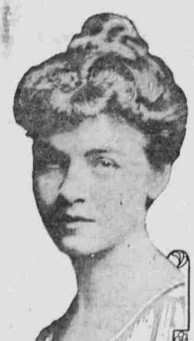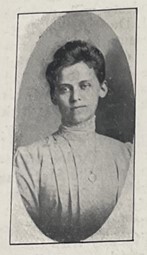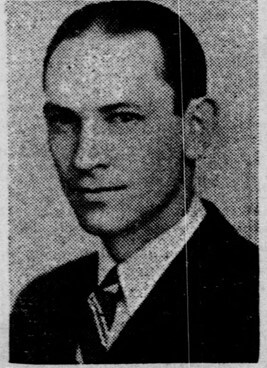Arguing for Equality: The Start and End of the Ban on Women from UNL Debate
Nevin Butler, History 250: The Historian Craft, Spring 2024
Founded in 1871, the University of Nebraska-Lincoln’s intercollegiate debate team was created to set up students for career and academic success by cultivating skills in critical thinking, public speaking, and teamwork. With its focus on these skills, debate has produced U.S. Senators, Supreme Court Justices, actors, journalists, and everything in between. The opportunities intercollegiate debate offers are invaluable for all students who wish to learn about the different perspectives of other college students across the country so that they can one day solve the political, social, and economic problems that plague the world. But these opportunities, at the University of Nebraska-Lincoln and other colleges and universities in the U.S., have not always been open or equally accessible to everyone. Women have historically been prohibited from participating in intercollegiate debate, and even those allowed to debate have faced gender-based discrimination within the debate community. The University of Nebraska-Lincoln’s ban on women joining the debate team from 1871-1941 perpetuated misogynistic stereotypes that future women debaters on the team would disprove. [1]
For the first 70 years of the UNL debate team, women were not allowed to join the team or represent the university at any interstate debate tournaments. When the debate team was founded in 1871, the membership clause of the team’s constitution only allowed for “male” members to join the debate team, creating a de jure ban on women debaters. It was not until 1901 that the word “male” was removed from the membership clause causing much controversy. Members of the team who were against removing the male requirement for membership commented that women would “[take] advantage of their sex” to not pay organizational dues and that it would be difficult to find “competent women debaters”. Once the word “male” was removed from the membership clause, women were still not asked to join the team and would not be asked to join the team for 40 more years. Thus a de facto ban on women began, enforced by coaches and members of the debate team, which would last until the fall of 1941. [2]
During UNL’s ban on women debaters, other midwestern universities such as Bellevue College (now Bellevue University) and the University of Wisconsin allowed women to join their respective debate teams. Men debating for Nebraska and other midwestern universities used misogynistic and discriminatory language against the few women debating on the midwestern debate circuit. For example, Anne Johnson representing Bellevue College, the only woman debating in 1916 in the state of Nebraska, was referred to as a member of the “weaker sex”, laughed at by men on her team, and ganged up on by other debaters in Nebraska. Misogynistic language and behaviors exhibited by the men in the Nebraska debate community created a hostile environment and served as a barrier to women debaters from equally participating in the activity. [3]
Even in the face of gender-based discrimination, women debaters proved they could be successful at intercollegiate debate. Representing Bellevue, Anne Johnson won and was runner-up for multiple state debate contests. Adda Guttery, also representing Bellevue College, was the only woman to participate and place at the Nebraska Collegiate Oratorical Contest in 1904. Women from the University of Iowa, the University of Wisconsin, and the University of Minnesota all formed their own debate circuits that would have multiple successful tournaments starting in 1926. The proven success of women debaters and women debate circuits shows the obvious fact that women can equally participate in debate and forensic activities when given the opportunity. Yet as other midwestern debate teams began to open their doors to women, UNL would continue to maintain their exclusion for decades longer. [4]
UNL’s choice to continue excluding women from debate created a culture that accepted the mistreatment of women, which spills over into other contexts in and outside of education. Open discrimination against women in academic activities, such as debate, sends a message to everyone at UNL that women are not as smart or capable as men. These negative stereotypes create a ‘bro’ culture where men’s perspectives are centered, and women’s perspectives are devalued. Without the perspective of women in debate, harms against women in the activity go unaddressed, leading to the normalization of discrimination. Since debate and college are meant to prepare students for their future careers, the stereotypes and harms normalized at UNL also permeate the workforce. In political and employment leadership positions, women are underrepresented, face harsher criticism, and work under misogynistic stereotypes. Addressing misogyny in UNL debate is a first step in addressing the systemic misogyny that plagues political institutions and places of work. Debates about the ban on women debaters at UNL would begin the process of addressing UNL’s role in upholding misogyny. [5]
Leading up to 1941, debates on campus about the inclusion of women on the UNL debate team began to occur between coaches and members of the team. The arguments used in these debates showed the underlying misogyny in the reasoning to purposefully exclude women. On one side of the debate, H. A. White - the coach of the debate team immediately before the end of the ban on women - made his position on women debaters crystal clear. When asked why women were not allowed on the team, White argued that it would be “impossible, from a practical point of view, to have both men and women on the same team.” Specifically, he thought that women had no interest in joining the debate team and found it ridiculous to hire a chaperone for out-of-town tournaments, which was required by the university when men and women traveled together for school-sponsored activities. Speaking for all the men on the debate team, White also claimed that men would not debate on a team with women on it. [6]
None of White’s arguments against women joining the team were rooted in the type of logical thinking that debate is meant to promote but rooted rather in White’s misogyny. The argument that women had no interest in debate was illogical because never in the university’s history had women been provided a chance to show such interest because they were banned from the team. Women would reasonably not show interest in an activity that for the first 60 years of its existence had made clear they were not welcome. Through framing the ban on women as “practical”, White rationalizes misogyny on the debate team and hides behind straw man arguments instead of trying to find a way to ensure that women could equally participate in the education activities at their own university. [7]
The next coach of the debate team was Dr. Leroy Laase also argued against allowing women to join before he eventually allowed women to join the team in 1941. Coach Laase echoed extremely similar arguments as White. He questioned the ability to find any “interested or competent women debaters” to join the debate team and was concerned about finding a chaperone for coed travel. Laase’s presumption that women were not as competent or interested in debate as men shows gender stereotypes permeating the thought process behind the prohibition of women debaters. Until these ideas were deconstructed, negative views of women continued to systemically keep them out of the UNL debate space. [8]
On the other side of the debate, some male debaters advocated for women to be allowed to join the debate team. Walter Hugo, a member of the UNL debate team, wrote to the Daily Nebraskan to express his belief that women’s inclusion in debate would be integral to the debate team's success. He reasoned that there was no good reason why a woman who made it through the same audition process as a man should not be allowed to represent her school in intercollegiate debate and gain the same educational benefits as her male counterparts. In fact, Hugo blamed, in part, the lack of interest in students joining the debate team over the last year on the barring of women as they made up a large portion of the student body. Proponents of gender equality by members of the debate team show that misogyny did not need to be a bedrock of the debate community. The public support also showed debaters using the critical thinking and advocacy skills that debate had cultivated in them to improve the debate space itself, clearly disproving Coach White’s claim that no male debater would debate with women on the team. [9]
Through the support of Hugo as well as the support of academic fraternities and sororities, women were finally allowed to participate in intercollegiate debate for the first time in the university’s history in the fall of 1941. The student pressure and the lack of an actual de jure rule preventing women from joining the debate team is what led Coach Laase to forever change the course of UNL debate by ending the de facto ban on women debaters. In the first year of allowing women to participate in debate, six women - Betty Newman, Jo Ann Emerson, Roma Biba, Louise Woerner, Joyce Burke, and Mabel Jean Schmer - joined the debate team, breaking the glass ceiling for all the women that would follow. [10]
Women debaters immediately joining the debate team after Laase ended the ban dismantled misogynist ideas used to maintain women’s exclusion. The ‘concern’ for women’s interest and competency was disproven when, after only six years, the original six women debaters became fifteen, making a fourth of the entire team. Most of these women also had previous debate or forensic experience from high school. Any coed travel issues were easily solved by hiring a women assistant coach - Helen Meyer, a former debater for MacMurray College and the University of Wyoming - who could both coach women on the team and act as a chaperone when the team travels out of town. In the words of Coach White, the “impossible” had become possible. [11]
Once women debaters became a reality at UNL, they challenged the misogynistic stereotypes placed on them by male debaters and coaches. In the next decade after 1941, multiple women won high debate rankings and honors such as B. J. Holcomb and Eloise Paustian who both won the 1948 University of Minnesota tournament. The importance of women debaters also grew while men were drafted and volunteered to fight in World War II. In 1943, UNL debate was solely represented by women debaters because every male debater was fighting in the war or quit. The next year, the annual Nebraska debate conference hosted by Coach Laase had more teams entered in the women’s debate division, 28, than the men’s, 26. Women debaters at UNL, once stereotyped as incompetent, uninterested, and the weaker sex, were now carrying the UNL debate team on their backs. [12]
With women becoming increasingly successful on UNL’s debate team, the treatment of women debaters improved by the university at large. The Daily Nebraskan, UNL’s student newspaper, began to have columns that exclusively covered the women’s debate team, uplifting the women’s success and legitimizing the necessity of women in debate. Historically using misogynistic language and publishing misogynist stories about women in debate, the student newspaper now began to publish multiple articles highlighting the discrimination women faced in debate and their fight to be treated equally on the team. Not only showing a shift to more equitable views of women on campus, the Daily Nebraskan articles' presentation of women debaters’ perspectives also serves to inform other women at UNL that debate can be a safe academic space for them. These articles also force men to see women in an active academic role not as subordinates, but as equals. [13]
Although women were making gains within UNL debate, many barriers for women remained. Women were still in a separate debate circuit from their male counterparts and only competed against other women. If women and men were assumed to have an equal ability to debate, then there would be no reason to have two different circuits for men and women. The separation of the sexes into two different categories implies that men are more intelligent than women and therefore women and men cannot debate on equal levels. Statistically, there are no relevant or significant differences in general intelligence based on gender. Outside of the world of facts and logic, misogyny-fueled stereotypes of men as the superior sex are what led people to believe that women should not debate men. Separate circuits for each gender would last for decades after the ban on women ended until being phased out incrementally to the single circuit for all genders that UNL has today. [14]
Overall, UNL debate’s treatment of women in the first half of the 20th century reflects the normalized misogyny of the general society and shows the excellence of women debaters who succeeded in debate. Both the legacy and struggle of the first UNL women debaters in 1941 live on today within the UNL debate team and the debate community at large. Women continue to disproportionately lose debate rounds, get called aggressive more, get critiqued based on their clothing more, face sexual harassment in and out of debate rounds, and be excluded from male-dominated debate squads. Steps the UNL debate team took to include women in the 1940s cannot be the end of uplifting women debaters and addressing the misogyny in the debate community. Debate teaches students the basic skills of advocacy, so it only follows that the debate community should advocate for all its members to receive fully the activity’s benefits. [15]
Notes
[1] NSDA, “Notable Alumni.” National Speech & Debate Association. ND. https://www.speechanddebate.org/notable-alumni/ (accessed May 1, 2024).
Daily Nebraskan, “Women Asked To Participate In UN Debate.” Sept. 26, 1947. From Nebraska Newspapers. https://nebnewspapers.unl.edu/lccn/sn96080312/1947-09-26/ed-1/seq-4/ (accessed Apr. 12, 2024). (hereafter DN, 1947.)
[2] DN, 1947.
[3] Omaha Daily Bee, “Mere Male Students Will Have Chance When This Girl Leaves the College.” Jun. 4, 1916. From Nebraska Newspapers. https://nebnewspapers.unl.edu/lccn/sn99021999/1916-06-04/ed-1/seq-10/ (accessed Apr. 12, 2024). (hereafter ODB, 1916.)
[4] ODB, 1916.
Purple and Gold, “Nebraska Collegiate Oratorical Contest, 1904.” Feb. 1904, Pamphlet. Box 2, Folder 2, RG 45-02-00, Intercollegiate Debate Seminary, Records, Archives & Special Collections, University of Nebraska-Lincoln. (hereafter P&G, 1904.)
Daily Nebraskan, “Women’s Intercollegiate Debate Included in Program at Wisconsin.” Nov. 23, 1926. From Nebraska Newspapers. https://nebnewspapers.unl.edu/lccn/sn96080312/1926-11-23/ed-1/seq-3/ (accessed Apr. 12, 2024). (hereafter DN, 1926.)
[5] Alegria, Penelope, “‘Bro Culture’ Is Debate Culture.” Harvard Political Review, October 10, 2020. https://harvardpolitics.com/bro-culture-is-debate-culture/ (accessed Apr. 12, 2024). (hereafter Alegria, 2020.)
Women’s Debate Institute, “Women In Debate: A Best Practices Manual.” Mar. 2022. https://www.womensdebateinstitute.org/wp-content/uploads/2022/03/wdi-best-practices.pdf (accessed Apr. 12, 2024). (hereafter WDI, 2022.)
[6] Daily Nebraskan, “Intramural Debate Favored By White.” Feb. 23, 1932. From Nebraska Newspapers. https://nebnewspapers.unl.edu/lccn/sn96080312/1932-02-23/ed-1/seq-1/ (accessed Apr. 12, 2024). (hereafter DN, 1932.)
[7] DN, 1932.
[8] Daily Nebraskan, “Debaters State Trip Preferences Tonight.” Oct. 21, 1941. From Nebraska Newspapers. https://nebnewspapers.unl.edu/lccn/sn96080312/1941-10-21/ed-1/seq-2/ (accessed Apr. 12, 2024).
[9] Huber, Walter, “Why Not Debate?” Daily Nebraskan. Mar. 1, 1932. From Nebraska Newspapers. https://nebnewspapers.unl.edu/lccn/sn96080312/1932-03-01/ed-1/seq-2/ (accessed Apr. 12, 2024).
[10] Daily Nebraskan, “Coed Debate Squad Enters Intercollegiate Activities.” Nov. 12, 1941. From Nebraska Newspapers. https://nebnewspapers.unl.edu/lccn/sn96080312/1941-11-12/ed-1/seq-1/ (accessed Apr. 12, 2024). (hereafter DN, 1941.)
[11] Daily Nebraskan, “Discussion, Debate Participants Now Total Fifty-seven.” Oct. 6, 1946. From Nebraska Newspapers. https://nebnewspapers.unl.edu/lccn/sn96080312/1946-10-06/ed-1/seq-4/ (accessed Apr. 12, 2024).
DN, 1941.
DN, 1932.
[12] Daily Nebraskan, “Two UN Coeds Take Women’s Debate Crown.” Mar. 4, 1948. From Nebraska Newspapers. https://nebnewspapers.unl.edu/lccn/sn96080312/1948-03-04/ed-1/seq-4/ (accessed Apr. 12, 2024).
Daily Nebraskan, “Gals Get Spot Behind Rostrum.” Feb. 21, 1958. From Nebraska Newspapers. https://nebnewspapers.unl.edu/lccn/sn96080312/1958-02-21/ed-1/seq-1/ (accessed Apr. 12, 2024). (hereafter DN, 1958.)
Daily Nebraskan, “Representatives from 26 Colleges Meet for Debate.” Feb. 25, 1944. From Nebraska Newspapers. https://nebnewspapers.unl.edu/lccn/sn96080312/1944-02-25/ed-1/seq-1/ (accessed Apr. 12, 2024). (hereafter DN, 1944.)
[13] ODB, 1916.
DN, 1932.
DN, 1958.
[14] DN, 1944.
Hunt, Earl, “Human Intelligence.” Cambridge University Press, 2011. p. 389. ISBN 978-1139495110.
[15] WDI, 2022.
Alegria, 2020.
[16] ODB, 1916.
[17] P&G, 1904.
[18] Daily Nebraskan, “Laase New Debate Head In Shake-up.” Sept. 24, 1941. From Nebraska Newspapers. https://nebnewspapers.unl.edu/lccn/sn96080312/1941-09-24/ed-1/seq-1/ (accessed Apr. 27, 2024).



